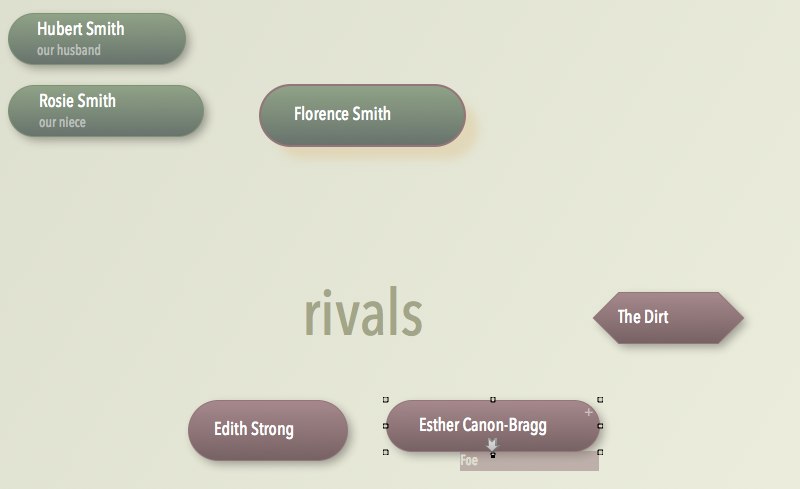Prototypes
Part 3 of an online seminar on Tinderbox and World Building for fiction and creative nonfiction. Join us! Email questions and suggestions to Mark Bernstein.

Florence Smith, a young woman of very modest means and no particular family, longs to own a truly great painting. Her husband, Hubert, is a pleasant fellow, but it hardly seems likely that he will soon earn a great deal of money. At present, Florence can barely manage a maid and a cook — and she really has no idea where Cook’s wages are to be found.
Also standing in Florence’s way are two rivals, art lovers who greedily want to collect all the best paintings and all the best new painters. Edith Strong and Esther Canon-Bragg have many advantages; our story relates how Florence is to overcome them.
Florence has a third antagonist: The Dirt. The Dirt was the nemesis of all Victorian women, at least women of moderate means. Unless she takes stern and unceasing measures against The Dirt, it inexorably accumulates and brings disease, dishonor, and depravity in its wake.
This is, of course, how people wrote about dirt, and how many Victorians regarded it. In some aspects, they were right; in others — the dangers of bathing, the hazards of sleeping with open windows and adequate ventilation — they were mistaken. For the purposes of this story, I want to take Victorians at their word: The Dirt is an active, malevolent force that, if ignored even briefly, can destroy the health and character of every member of the domestic circle.
In time, we may have other rivals, too. Perhaps our claustrophobic maid Annie will develop a conflict with a neighboring servant. Perhaps our pretty niece Rosie will encounter opponents of her own.
In the map, it’s useful to distinguish our foes visually. Here, they have a distinct color. Notice that The Dirt shares the color scheme — it’s an opponent — but doesn’t share the same shape as the characters. The dirt, after all, is not a person.
A drawing program like MacPaint or Visio® would let you draw a map like this one, but you’d have to draw each item separately. Tinderbox lets you use a prototype — a note that serves as an example for other notes. Here, we’re using the built-in prototype “Person” for all the characters, and I’ve just added a new prototype. Foe, for our rivals.
A note inherits the properties of its prototype. So, all the characters have the same shape because they inherit that shape from Person. A Foe inherits its shape from the Foe prototype, which in turn inherits a shape from Person. So, we say “create me a new Foe”, and all the settings are automatically inherited.
Better still, inheritance is a live, active property. Next week, if I change the color of the Foe prototype, all my Foes will immediately inherit the new color.
Finally, even if a note has a prototype, it can override anything the prototype specifies. So, The Dirt is a Foe and it inherits the color of a Foe. But it’s not a person; I give The Dirt its own distinctive shape, and that overrides the normal shape.
Inheritance turns out to be a very nice part of Tinderbox. Almost every aspect of a note can be inherited. Later, we can use prototypes for their meaning, too: if we want a list of all every character in the story, we can simply ask Tinderbox for every note whose prototype is Person.
Questions? Alternatives? Corrections? Improvements to the story? Join the conversation: email bernstein@eastgate.com . We'll be back in a day or two with part four, where we’ll learn more about The Dirt.
Try Tinderbox
for Mac OS X ❧ More download options.
Buy Tinderbox
Tinderbox for you, for your team, or your enterprise. Plus upgrades, The Tinderbox Way, and more. Order here.